When I started my career in archaeology, heritage was all about things — the artifacts, the archaeological sites, the physical traces of long-ago people’s lives. Those objects were the pathway to the past.
For me, that view began to change almost 25 years ago through an encounter with a middle-aged First Nations woman in an archaeology class I was teaching. She came to me one day and said, “I can’t give you my paper today.”
“Why?,” I asked, mentally reviewing the standard litany of student excuses.
She said, “I can’t give it to you because my spirit helper left me.”
My first reaction was “well, that’s one I haven’t heard before.” But a split-second later, the lightning bolt of understanding struck and I realized that despite what we had in common — the shared language and Levi’s — that there were fundamental differences in our worldviews. Something profound had happened to me.
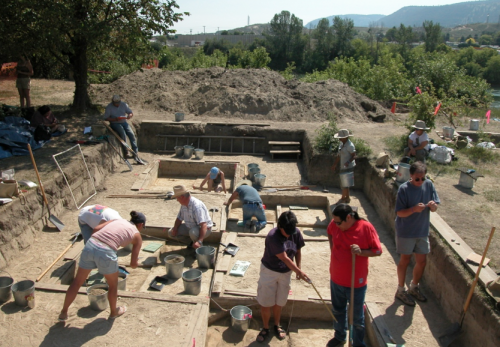
At very top, projectile points, Kamloops, British Columbia; above, excavation of 6,000-year-old habitation site by Indigenous Archaeology students, Kamloops, BC (photos: G. Nicholas, used with permission).
Today I am still an archaeologist studying artifacts, excavating archaeological sites, and teasing apart the record of people’s lives from long ago. But my perspectives about such things have been strongly influenced by interactions with Indigenous peoples in Canada and elsewhere. Through them, I have come to learn that the real values of heritage are not in the objects and physical places but in the intangible knowledge they contain or convey.
So this is much more than a story of personal enlightenment because it speaks to issues that continue to unfold worldwide regarding the rights and needs of Indigenous peoples. The distinction between Western and Indigenous societies figures prominently in heritage matters. And the challenges faced by Indigenous peoples are substantial — the loss of land, of language, of sovereignty. There is also the loss of control over their own heritage — what should be a basic human right.
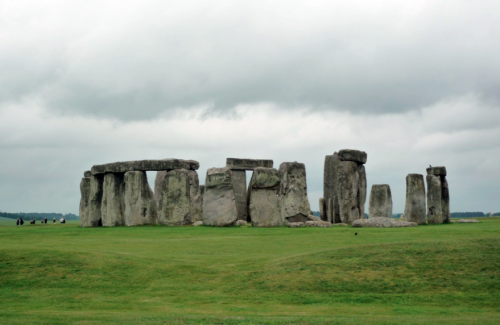
Stonehenge, England (photo: G. Nicholas, used with permission).
Western society certainly supports heritage preservation through legislation and management policies, museums that preserve and promote local and national histories, and so on. There is also a public fascination with old things — archaeological sites, heritage places, artifacts and historical objects of all time periods and cultures — from the earliest record of humanity to the very recent past, including the discovery of the Franklin Expedition ships that has so strongly captured everyone’s attention… except for the Inuit, who always knew where they were.
At the same time there is a huge rift between Western and non-Western ways of caring for heritage. Not only do Indigenous peoples have little control over their own affairs, but their ways of life and traditional knowledge have been largely viewed as public domain, free for the taking. Concerns about the exploitation and appropriation of their culture are rampant.
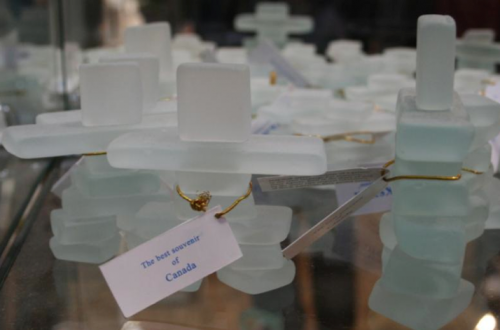
Replica inukshuk in giftshop (photo S. Roth, used with permission).
One doesn’t have to look far to find artifacts and artwork transformed into cheap souvenirs, valuable commodities, clothing fashions, or otherwise used in ways far from their place of origin and original purpose. Traditional knowledge has become a valuable resource for academics, authors and musicians, for biotech and pharmaceutical companies, and others, often without permission and generally with little or no benefits flowing back to source communities. Human skeletal remains and DNA are a strong point of contention. The result is that real cultural, spiritual, and economic harm occurs to real people.
All of us have a responsibility to be respectful of others — something that most of us want to do but we may not always be aware of how best to respect heritage values and cultural needs. And it is demeaning to always put broad scientific values ahead of those whose ancestors created the heritage sites we study or visit today. The artifacts and sites are their cultural patrimony; the traditional knowledge is their intellectual property.
So… what do people need to know about Indigenous heritage values that will let us consider “heritage” in a more informed and respectful way? Here are six lessons I’ve learned.
1) Heritage is not just about things. Ancient objects are important touchstones of history, and reveal much of scientific importance. However, no artifact, no archaeological site has any meaning without the intangible values brought to them.
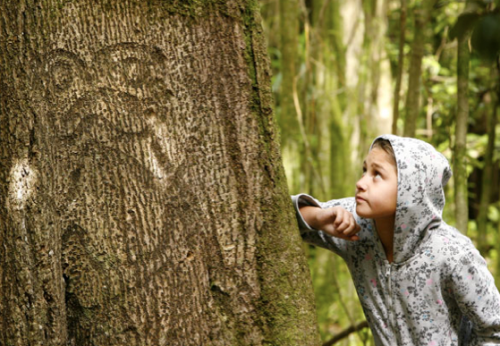
Moriori descendant, Nicole Whaitiri with a living tree carving on Rekohu, also known as the Chatham Islands (R. Giblin, courtesy Hokotehi Moriori Trust, used with permission).
2) Heritage isn’t limited to “the past.” For some Indigenous peoples there is no division between culture and nature, or between the natural and supernatural realms. And past and present may be folded together. This means that ancestral beings and other forces are part of this existence, such as my student’s spirit helper. For this Moriori girl in New Zealand (right) the carved tree is a living ancestor — that being is there right now.
3) Heritage permeates the fabric of Indigenous societies. “Heritage” as a concept really doesn’t exist in many Indigenous societies since it is entwined with all other facets of people’s lives. Thus the loss of an ancestral site is not just a loss of history but a separation from places important to them, and a threat to wellbeing and way of life. One elder once told me that the destruction of a traditional food gathering place felt to her as if an arm had been severed.
4) Heritage is largely intangible. It reflects a society’s engagement with the world through its material culture but especially through its collective knowledge, experiences, traditions, and origin stories that both shape and reflect what people do.
5) Heritage research may have unintended consequences. Research on archaeological materials, including ancient DNA studies, can yield great insights into ancient people’s lives, including population movements in the past. But that information can also challenge a community’s origin beliefs, threaten an individual’s identity, or complicate land claims.
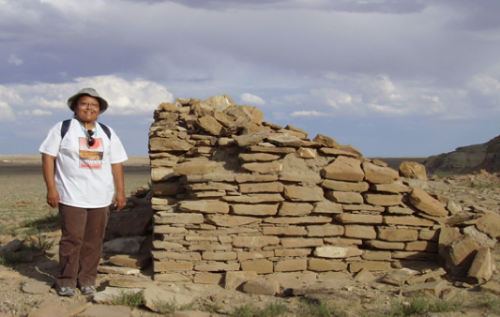
Navajo archaeologist Davina Two Bears (courtesy D. Two Bears, used with permission).
6) Heritage needs to managed by the heritage holders. All peoples need to have to have access to and be able to make decisions about their own heritage in whatever form it takes. How can outsiders make decisions about someone else’s heritage when they are unaware of, or don’t understand, local values, needs, and consequences?
None of this is rocket science. For Indigenous peoples this may all be common sense. But it isn’t common knowledge for the majority of academic researchers, policy makers, and the public at large for whom Indigenous culture is a ready source of art, entertainment, and research subjects. And many people are unable or unwilling to give up control of heritage management, or are skeptical of the legitimacy of traditional knowledge.
But what if we turn things around? What happens when we approach heritage issues informed by these perspectives? Some very interesting things — as I’ve learned by being part of an international research initiative, the Intellectual Property Issues in Cultural Heritage project. This project has supported a series of research initiatives in which the community is in the driver’s seat, conducting research on topics of importance to them, using scientific methods as well as other ways of knowing informed by local values. To briefly note just three of these:
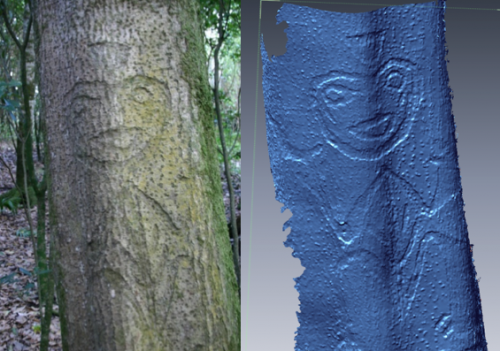
Laser-scanned image from rakau momori (living tree carving) on Rekohu (photo courtesy Hokotehi Moriori Trust, used with permission).
• The Moriori of the Chatham Islands, New Zealand, are systematically recording archaeological and heritage sites, including the sacred groves of the living ancestor trees. Some of these trees are diseased so the images on the trees are being laser scanned; recording this information is important to them. They also developed a cultural database to preserve that information along with elder’s knowledge to better make land-use decisions, in the process helping to re-connect youth to elders through their participation;
• The Saginaw-Chippewa of Michigan today conduct ceremonies on a large piece of exposed bedrock covered with over one hundred petroglyphs or carved images—what they call “teachings.” The property is owned by an archaeological society and managed by the state as a park. The tribe is trying to negotiate a co-management plan, as well as obtain a key to the fence that encloses the panel so they don’t have to ask permission to access their own heritage; 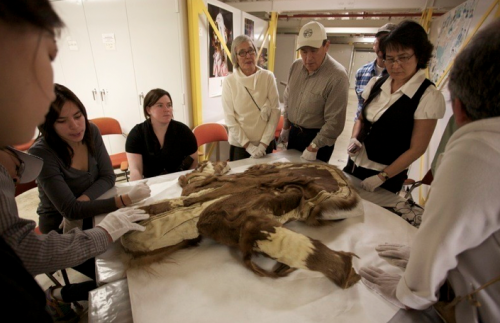
Inuvialuit delegates examine a parka at the Smithsonian Museum Support Centre, Nov. 2009 (Dave Stewart, Inuvialuit Living History website).
• The Inuvialuit of the western Arctic have developed a repatriation project concerning a collection of clothing, tools, and other objects made by a Hudson’s Bay employee over 150 years ago, which are now in the Smithsonian Institution in Washington. But the Inuvialuit don’t want the objects themselves repatriated but the information contained in the traditional items, including old styles of clothing and mukluk patterns. A research team consisting of Inuvialuit elders, youth, scholars and filmmakers travelled to Washington, and spent a week examining and recording the items. That information is now available to the community.
What projects like these demonstrate is that when the community is in the driver’s seat, local needs are met and new knowledge gained. And by acknowledging that all peoples have the right to make decisions about their own heritage sites and traditional knowledge, we can be respectful of them while being enriched by what they may willingly share.
Because ultimately heritage is not about things; it is about relationships and what these things mean to people.

This TEDx event was held in conjunction with “Itaa Yati: A Symposium on Traditional Knowledge” in Yellowknife, NWT. The TEDx videos and other conference videos will be available soon.






